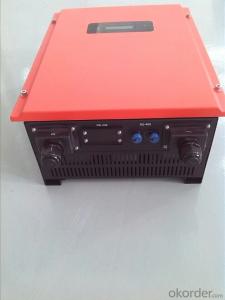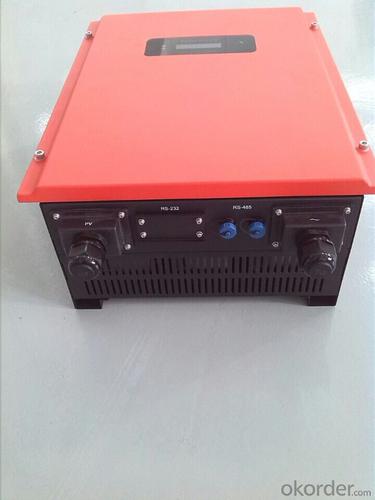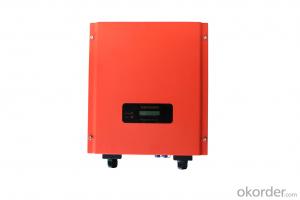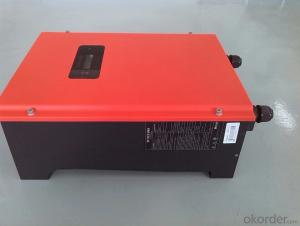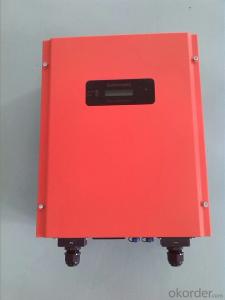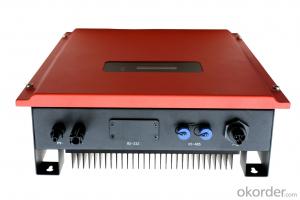Grid Tie Solar Inverter Sunteams 1500-3000(US)
- Loading Port:
- China Main Port
- Payment Terms:
- TT OR LC
- Min Order Qty:
- -
- Supply Capability:
- -
OKorder Service Pledge
Quality Product, Order Online Tracking, Timely Delivery
OKorder Financial Service
Credit Rating, Credit Services, Credit Purchasing
You Might Also Like
The Sunteams 1500 ~5000 series is applicable to various rooftops and small scale photovoltaic grid-connected power plants. Their nominal output powers are 1.5 kW, 2 kW, 2.5 kW,
3 kW, 3.6 kW, 4 kW and 5kW respectively.
This series is transformerless and has a wide range of MPPT input voltage. Its maximum conversion efficiency and MPPT tracking accuracy reach 97.6 % and 99.5 % respectively. The maximum DC voltage reaches 550 V. Its multilingual LCD display facilitates easy operation. It has waterproof direct plug-in terminals. It has overvoltage, islanding, short-circuit, overloading and overheating protection functions. Its IP65 protection degree will ensure it runs well in various tough environments.
These units are available with or without wirebox.
UL certified
■ For countries with UL certification (UL 1741 / IEEE 1547)
■ For countries with UL certification (UL 1741 / IEEE 1547)
Efficient
■ The CEC efficiency of the inverter can reach 95.0 %-97.5 %
■ Transformerless desi
■ The CEC efficiency of the inverter can reach 95.0 %-97.5 %
■ Transformerless desi
Simple
■ ‘Plug and play’connection for easy installation and maintenance
■ Designed for hanging with simple and easy installation
■ Fanless cooling concept
■ ‘Plug and play’connection for easy installation and maintenance
■ Designed for hanging with simple and easy installation
■ Fanless cooling concept
Communicative
■ RS232/RS485 interfaces as standard
■ Optional Bluetooth technology
■ RS232/RS485 interfaces as standard
■ Optional Bluetooth technology
- Q: How does a solar inverter handle variations in temperature?
- A solar inverter handles variations in temperature by employing temperature compensation techniques. It continuously monitors the temperature of the solar panels and adjusts its output voltage and frequency accordingly. This helps maintain optimal performance and efficiency, as temperature changes can affect the electrical characteristics of the panels. Additionally, inverters may have built-in cooling systems or heat sinks to dissipate excess heat and prevent any damage caused by high temperatures.
- Q: What are the potential risks of electrical shock from a solar inverter?
- The potential risks of electrical shock from a solar inverter include accidental contact with live electrical components, inadequate grounding or improper wiring, and failure to follow safety precautions during installation or maintenance. Additionally, poor maintenance, lack of training, or using faulty equipment can further increase the risk of electrical shock.
- Q: What is the role of a power factor correction circuit in a solar inverter?
- The role of a power factor correction circuit in a solar inverter is to improve the power quality and efficiency of the inverter by reducing the reactive power and improving the power factor. This circuit ensures that the energy from the solar panels is effectively converted and delivered to the electrical grid, leading to a more stable and efficient operation of the solar inverter system.
- Q: Can a solar inverter be used with a solar air conditioning system?
- Yes, a solar inverter can be used with a solar air conditioning system. The solar inverter helps convert the DC power generated by the solar panels into AC power that is suitable for powering the air conditioning system. This allows for the utilization of solar energy to cool or heat a building, making it an eco-friendly and energy-efficient solution.
- Q: How does a solar inverter synchronize with the grid?
- A solar inverter synchronizes with the grid by constantly monitoring the grid's voltage and frequency. It adjusts its own output to match the grid's characteristics, ensuring that the electricity it generates is in phase with the grid's power supply. This synchronization process allows the solar inverter to seamlessly connect and feed electricity into the grid, maximizing the efficiency and reliability of the solar power system.
- Q: What is the role of a voltage regulator in a solar inverter?
- The role of a voltage regulator in a solar inverter is to maintain a consistent and stable output voltage despite fluctuations in the input voltage from the solar panels. It ensures that the electricity generated by the solar panels is converted and delivered to the connected devices or grid at the required voltage level, preventing any damage to the devices and optimizing the overall efficiency of the solar power system.
- Q: What are the key factors affecting the cost of a solar inverter?
- The key factors affecting the cost of a solar inverter are the type and size of the inverter, the brand and quality of the components used, the efficiency and power output rating, the features and capabilities such as grid-tie functionality or battery storage integration, and the installation and maintenance requirements. Additionally, market demand, competition, and economies of scale can also influence the cost of a solar inverter.
- Q: Are there any noise or vibration concerns associated with solar inverters?
- Yes, there can be noise and vibration concerns associated with solar inverters. However, the extent of these concerns will vary depending on the specific make and model of the inverter. Some inverters may produce a low humming or buzzing noise during operation, which is generally considered normal. However, if the noise becomes excessively loud or disruptive, it may indicate a malfunctioning or poorly installed inverter. Similarly, vibrations can occur in solar inverters, especially if they are not properly secured or mounted. These vibrations can potentially cause additional noise or even lead to damage if left unaddressed. Proper installation and maintenance practices, such as securely fastening the inverter and regularly inspecting for any signs of loose components or abnormal vibrations, can help mitigate these concerns. It is important to note that advancements in technology have led to the development of quieter and more efficient solar inverters. When selecting an inverter for a solar system, it is advisable to research and choose a reputable brand that has a track record of producing inverters with minimal noise and vibration issues. Additionally, consulting with a professional solar installer can provide valuable insights and recommendations to ensure a smooth and quiet operation of the solar inverter.
- Q: Can a solar inverter be used with different types of energy management systems?
- Yes, a solar inverter can be used with different types of energy management systems. Solar inverters are designed to convert the direct current (DC) produced by solar panels into alternating current (AC) that can be used in various electrical systems. They can be integrated with different energy management systems, such as battery storage systems, smart grids, or even hybrid systems that combine solar power with other renewable energy sources. This flexibility allows for efficient and optimized utilization of solar energy in different setups and applications.
- Q: What safety features should a solar inverter have?
- A solar inverter should have several safety features, including overvoltage protection, overcurrent protection, ground fault protection, and arc fault protection. Additionally, it should have robust insulation to prevent electrical shock hazards and be equipped with sensors to monitor temperature and prevent overheating. Finally, it should have a secure enclosure to protect against environmental factors such as water, dust, and debris.
Send your message to us
Grid Tie Solar Inverter Sunteams 1500-3000(US)
- Loading Port:
- China Main Port
- Payment Terms:
- TT OR LC
- Min Order Qty:
- -
- Supply Capability:
- -
OKorder Service Pledge
Quality Product, Order Online Tracking, Timely Delivery
OKorder Financial Service
Credit Rating, Credit Services, Credit Purchasing
Similar products
Hot products
Hot Searches
Related keywords
